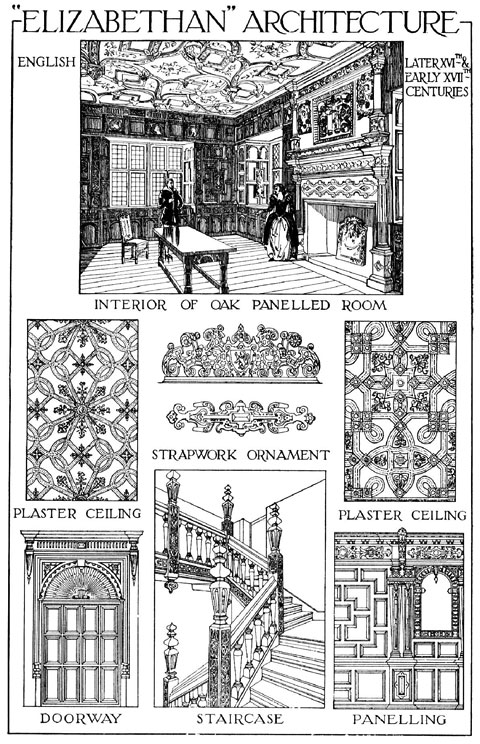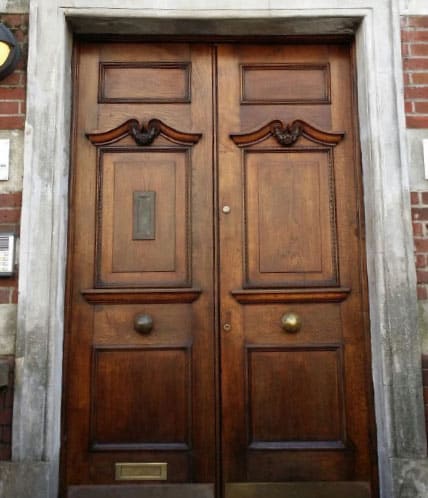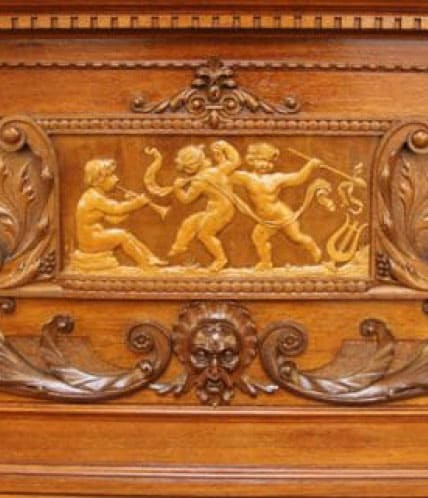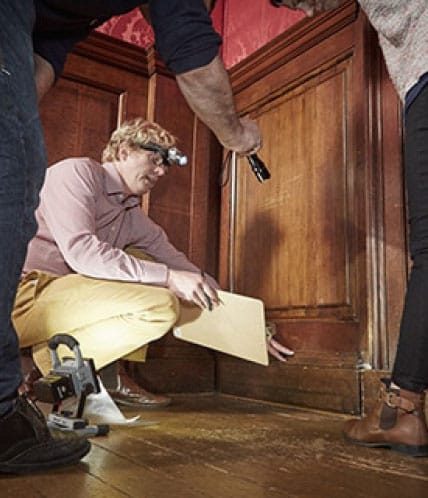During the Tudor period, the number of country estates and manor houses increased dramatically, built, not only by the nobility but also by smaller landowners and prosperous merchants. With peace more or less established, homes became about comfort, not fortification, and early Tudor homes represented the first vernacular style of house building in Britain.
Period Woodwork of Tudor, Elizabethan, and Jacobean Design
The wooden panelling in Tudor homes was typically oak and constructed using a technique called “boarded panelling.” This involved thin oak boards set into grooves and cut into solid timber uprights and cross members. The grooves were usually about 1/4 inch deep, and the boards were fitted tightly into them, leaving only a small gap between each.
The boards were generally no more than 24 inches square, split as thinly as possible to reduce warping and splitting. They were often decorated with carved designs, the linenfold being particularly popular in the 16th century.
It’s worth noting that the quality of the oak used for the panelling varied depending on the social status of the household. The wealthiest families would have had access to the best quality oak, while poorer families would have used lower-quality wood. Additionally, in some cases, the oak would have been painted or covered in plaster to imitate more expensive materials like stone or marble.
The Tudor period lasted from 1485 to 1603 and saw the reigns of five monarchs, including Henry VIII and Elizabeth I. This era was characterised by the English Reformation, a period of religious upheaval during which the Church of England broke away from the Roman Catholic Church. The Tudor style of architecture is known for its half-timbered houses, which feature exposed wooden beams and white plaster infill.
The new Tudor nobility, many of whom had profited from the dissolution of the monasteries, continued their house-building on a scale of increasing magnificence. Although national building traditions were too deeply rooted to be discarded suddenly, a departure from mediaeval methods was inevitable. A distinctive character was imparted to the early oak panelling design in Renaissance architecture of the Elizabethan and Jacobean periods.
The Elizabethan era followed the Tudor period, from 1558 to 1603, during the reign of Queen Elizabeth I. This was a time of great artistic and literary achievement, with playwrights such as William Shakespeare and Christopher Marlowe producing some of their most famous works. Architecture during this time was characterised by a mix of Renaissance and Gothic styles, with ornate carvings and decorations adorning buildings. Oak was the most commonly used wood for panelling during this time, but other woods such as pine and walnut were also used.
The Jacobean period followed the Elizabethan era, from 1603 to 1625, during the reign of King James I. This era saw a continuation of the Renaissance influence on English architecture, with a focus on symmetry and proportion. The Jacobean style is known for its use of intricate carvings and bold geometric shapes. Oak remained the primary wood used for panelling during this time, although other woods such as chestnut and cedar were also used.’
Architects of the time, John Thorpe, Robert Huntingdon Smithson, and Thomas Holt were renowned for their symmetrical oak panel designs, distinguished by horizontal lines and classic “orders.” In fact, few houses of the Elizabethan and Jacobean period had oak panelling details that were as elaborate as those found in their designs.
During the 16th century, wood panelling became a symbol of stateliness, dignity, and comfort. Walls, fireplaces, ceilings, and staircases were all ornately treated, and oak panelling became the norm. The Linenfold design gave way to plain rectangular shapes, surrounded by mitred mouldings. For a richer effect, carved pilasters and friezes, as well as the characteristic strapwork ornament, were introduced. Some panels even featured intricate patterns, and inlaid woods of different colours were occasionally used.
Oak panelling was so revered during this period that even gateways, balustrades, and rainwater heads were singled out for display .Each of these eras had a distinct style and unique architectural features, but they are all part of the larger story of England’s rich cultural and artistic history.
Restoring and Conserving Antique Woodwork
Restoration of antique woodwork requires careful conservation to maintain its historic significance. In this regard, it is essential to preserve the original character of the woodwork, while still allowing for the restoration of its original beauty. Professional conservators, such as Vincent Reed are trained in the various techniques used in restoration.
Tudor, Elizabethan, and Jacobean panelling represent a unique period of British domestic architecture that has stood the test of time. Their style and character have been carefully preserved over the centuries by professional conservators who understand the importance of theri unique history. As such, restoring, conserving, and renovating antique woodwork is a delicate process that requires expertise, skill, and a deep understanding of the woodwork’s unique characteristics.
Don’t hesitate to call Vincent for expert advice on restoring Tudor, Elizabethan, or Jacobean homes.







